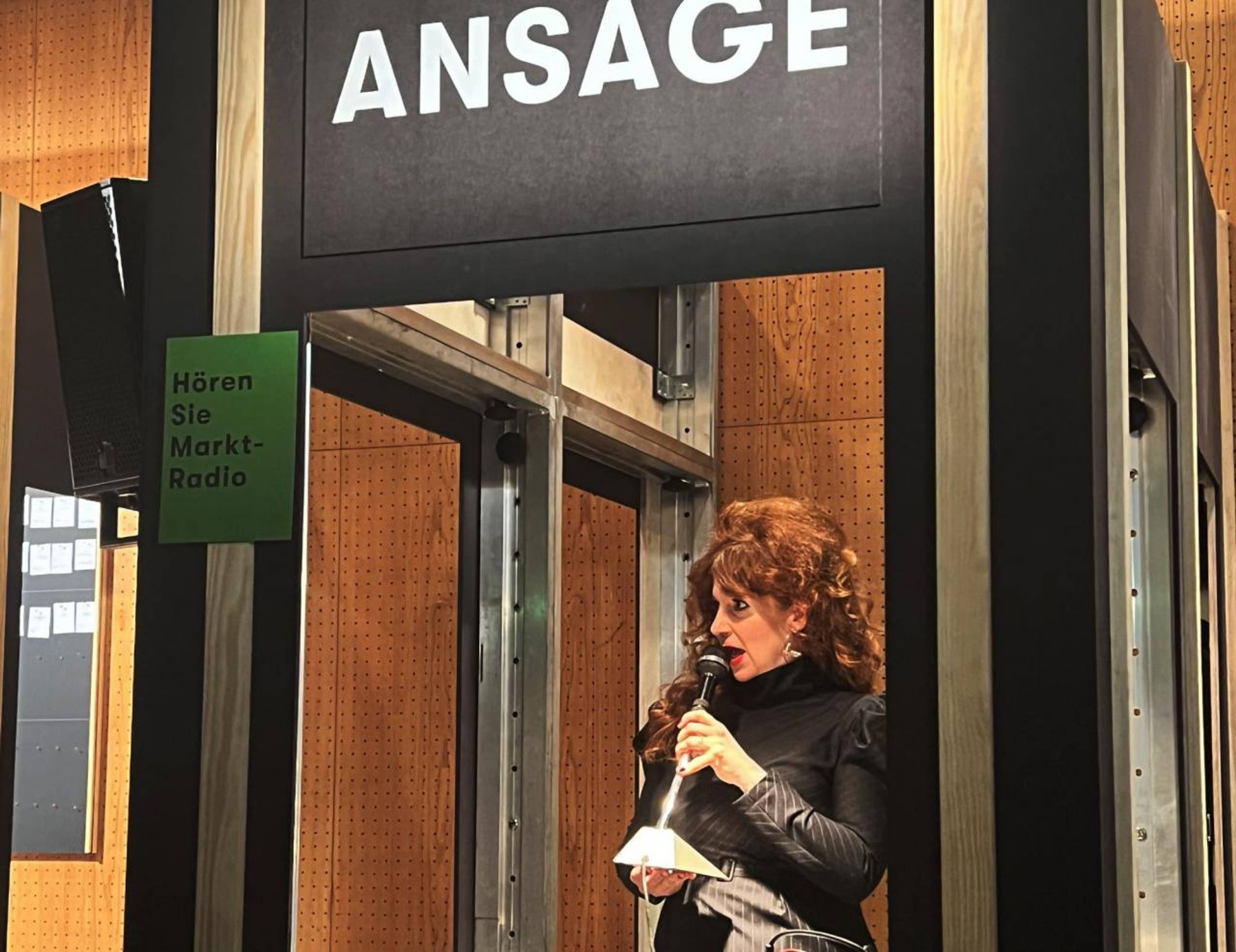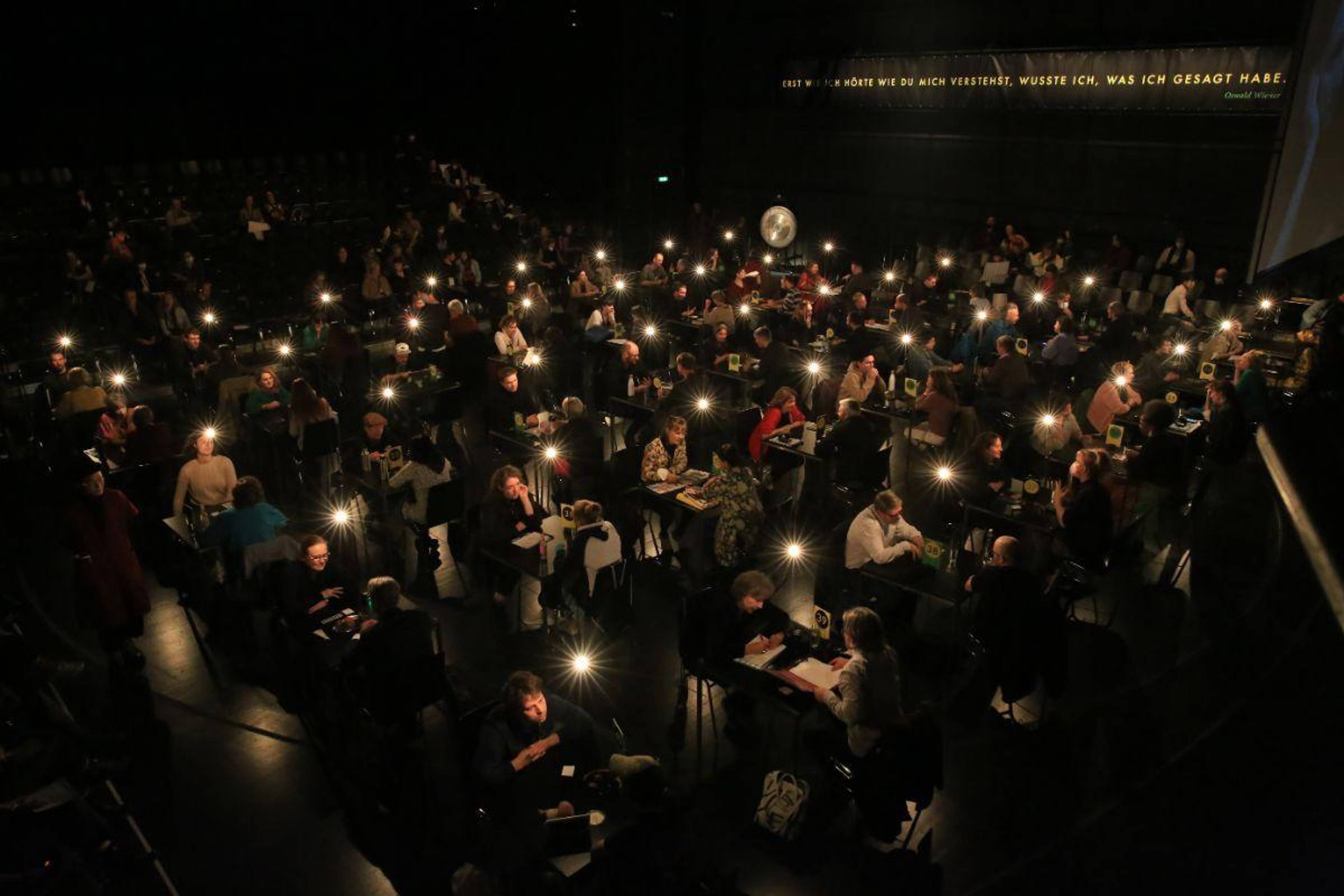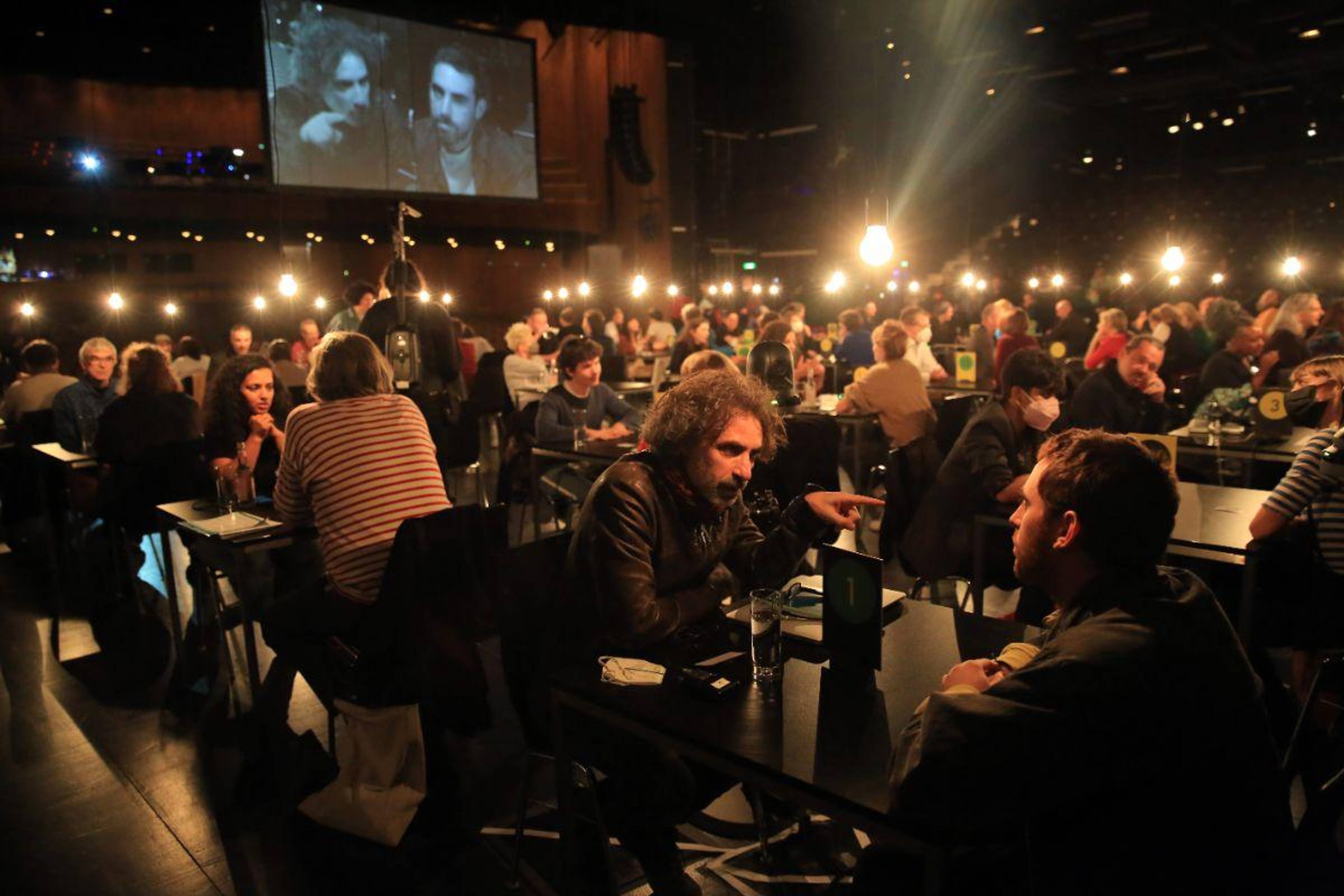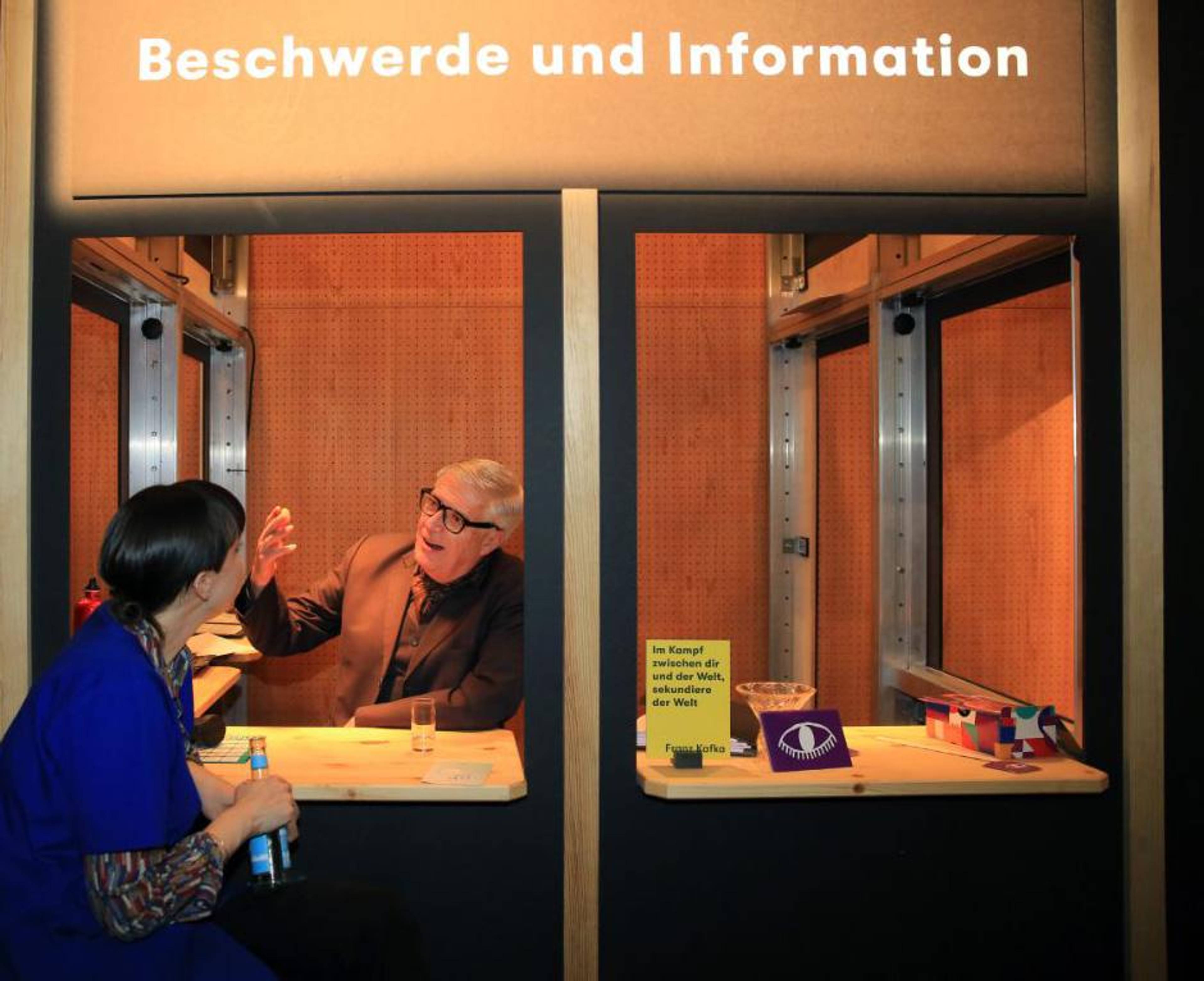Not that long ago, curator and dramaturge Florian Malzacher cold-messaged me on Facebook, introduced me to author and artist Cory Tamler, and extended me an invitation to something I instantly thought was a complete joke. I accepted and was thrilled to participate. Apparently, they had read some of the texts I had published especially one wherein I bitched about my generation’s shopping habits as though it were a single person, and they felt like I had expert knowledge to contribute to a market of knowledge and non-knowledge. I didn’t want to write that in italics so as to make it even more confusing. I’ll do it now. [The] Market for Useful Knowledge and Non-Knowledge (“Markt für nützliches Wissen und Nicht-Wissen”) is a synchronized performance, a theater obfuscating the boundary between audience and cast, which thrusts into the limelight, literally, our questionable ability to communicate.
This social experiment, one could call it, springs from the assessment that gaining knowledge is a lot more complicated than merely exchanging opinions with this or that person. Real knowledge must be provoked, harvested; impactful enough for it to mean something, its birth and sensation happen outside of the mundane. The result of a collective effort, producing knowledge should be about actively misunderstanding yourself in favor of understanding the other and vice versa. It should feel hallucinogenic, uncomfortable, throbbing, twisted, disorientating, like the performance of Volk in Luca Guadagnino’s Suspiria (2018), in which lethally ambitious girls whirl to the beat of their own loudly palpitating breaths. This kind of knowledge is not something worth remembering, but merely experiencing – in the moment, for the moment.
Cometh the hour, expansive rows of tables, each individually lit by floating lightbulbs, seat two interlocutors: an expert on the one side and a client on the other. The clients purchase their conversations at a cash counter outside of the arena. Only experts are offered a glass of water, so it’s easy to tell who’s who. The glass gets regularly refilled by coordinators dressed in Bordeaux-red robes, who are also in charge of alerting you when your thirty minutes of conversation are up. Once that happens, the light bulbs start palpitating and you can hear the aggressive chime of a massive gong situated in one corner of the room. Then, like speed-dating, the clients stand up, and new clients sit in their places. Rows on top of rows of bystanders can tune into the conversations through a radio broadcast available via their headphones, so you always have an active audience. Individually, the setup recalls a dodgy interrogation room, but because you’re looking at dozens, if not hundreds, of tables systematically enumerated in the center of an amphitheater, it feels more like the massive enrollment center for an overcrowded university. No less scary, but more calming, insofar as it exudes the feeling of authoritarian control.
View of the market during consultations, Haus der Berliner Festspiele, October 2022
My participation tested the boundaries of that control because, paying homage to Mike Crumplar’s Substack, I decided to show up tripping on a microdose of acid that ended up not being a microdose at all. Psychedelics felt appropriate and right, especially because this event and the art world at large love “negotiating” things critically, and what better way to do that than when your state of mind cannot tell space apart from time, so you’re forced to negotiate even those fundamental dimensions all over again. Arriving at the event’s location, having already spiraled solo for six or seven hours, I needed to prioritize charging my phone.
Planting myself near the only available socket, melting, I killed some time observing the nebula of general audience members walking in and queueing at different counters to buy their conversations. There was so much commotion: one Las Vegas-looking lady in an evening gown with huge, glittering earrings, substantial breasts, and an almost intimidating, Disney-esque hairdo vociferated announcements over a microphone; a lost old man went to the complaints counter and was told to “chill [the fuck] down”; some girls walking by were saying the encyclopedia of conversations is confusing and they can’t follow anything at all; a lot of people seemed to helplessly oscillate between corners of the room without anywhere specific to go. Then I wondered if this was all part of a hallucinogenic choreography. Spotting Cory, I decided to call her over. The conversation went like this:
Las Vegas Lady over the microphone: Remember, every conversation you have is a job interview.
Me: “Hey, Cory, tell me, are there people here who are purposefully instructed to confuse the audience?”
Cory: “No, actually not. What do you mean?”
Me: “I mean, to make the whole experience more psychedelic. Aren’t these people secretly here to confuse the public and challenge their preconceived notions of existing systems by giving them false, non-sensical information to make them even more attentive and involved, to lure them into the present moment?”
Cory: “No, not at all. They’re actually supposed to help them to their places. What did you see?”
Me: “Ah, nothing. Forget it. It’s a lot right now. ”
Cory: “Hahah, I get it.”
Me: “Do you?”
[Silence]
Cory: “No.”
Apart from that, I wasn’t really approached by any member of the public to have a conversation at all, which felt remarkable, considering they were all willing to undergo such a complicated process to incentivize communication, but wouldn’t think of chit-chatting with the person charging their phone right next to them. Go figure.
Despite Cory’s reassurances, I could still grasp the performance as a self-fulfilling prophecy, with bureaucracy and theater being two sides of the same coin. By this stage, I should probably mention how this observation tied in with the topics I was going to converse about, topics which I had almost entirely forgotten by the time my first client sat opposite my designated table. Thankfully, I brought printed handouts only comprehensible as abstract font, so I had to lead by asking this person what topic they were sold a conversation on.
Academia is only so obsessed with rendering thought as objective because that’s the only way it can be traded as capital
Then it all came back to me: how I was going to explain the concept of the “bimbo” as a cultural trope in the context of late-capitalist identity formation; how the English word was used as a derogatory term towards dandies in nineteenth-century, Italian-immigrant-riddled Brooklyn; how it was later converted into a misogynistic slur describing typically (thought-to-be) empty-headed, attractive, promiscuous, and wealthy women; how this image of the dumb socialite can be traced back to Jean Harlow, Marilyn Monroe, Monica Lewinsky, and Paris Hilton (and in that order); how it later became both a fetish in the SM community and a disgusting meme template circulating within online incel forums; how in the past two years typically Gen-Z female users on TikTok have begun owning this over-sexualized, cliché aesthetic as a commentary on self-actualization, sex-positivism, performativity, and Marxism; how this resurfacing is part of a wider Y2K nostalgia; how the trend already resonates with a plurality of gender identities that go beyond the original white-cis-heteronormative-woman paradigm; how “bimboification” as a performative act of walking around ironically imitating the opposite of what you believe yourself to be leads to a discrepancy of the self; how this discrepant tendency of behaving and dressing in a half-joking/half-serious way is a reactionary coping mechanism, as well as a form of resignation from late-capitalist state control; how this phenomenon could be used to sustain my belief that the only political agency is within the individual and not in the collective; how juggling these two alternate ways of presentation leads to an individual existence which manages to transgress the inherently oppressive nature of identity and self-commodification; how this all ties in with post-modern capitalist critique, the Frankfurt school, Deleuze and Guattari’s Anti-Oedipus (1972), and more contemporary household names like Mark Fisher, Slavoj Žižek, and Fredric Jameson; how all of this has the potential to actually bring back essence to life by obfuscating any binary interpretation of the present moment; and so forth and so on.
I was short of asking why a raven is like a writing-desk.
Theater-maker and artist Rabih Mroué
Some of my clients merely asked questions, others actively contested my points. I remember a woman telling me about her friend telling her that he finds it highly problematic how young people no longer take things seriously these days and use pseudo-nihilism as an excuse for taking the piss. This accusation I adamantly contested. Overall, exchanges were friendly and enriching, and there was a consensus the theatrics of it all were a little much. No one really needed to hear that gong. My last client was around my age, and that saved me a lot of explaining, but what was even more satisfying is that she was slightly on acid too, having (actually) microdosed that morning. So we ended up talking about that and Berghain and all the other good stuff – I slipped in some prepared topical points regarding hyper-consumerist behavior to feel like less of a fraud.
Coming down, I peddled along the yellow, orange, and red leaves of West Berlin’s gayest district, Schöneberg, thinking about the use of discourse in our day and age and whether I should break my promise not to purchase any more poppers from the cruising bar 700 meters away.
Akin to capturing a wild animal, thoughts have to be tamed before becoming their thinker’s cattle
Turning the corner, one conclusion: the active production of discourse serves institutions because it legitimizes their role in society, and it serves individuals only insofar as they can capitalize on it by categorizing themselves as “experts,” thus gaining status to monetize.
Academia is only so obsessed with rendering thought as objective because that’s the only way it can be traded as capital; hence the chummy relationship between nation-states and universities, between innovation and science: use value. You turn something as immaterial, fluid, and contingent as thought into a thing by restricting its very character. Akin to capturing a wild animal, thoughts have to be tamed before becoming their thinker’s cattle. Fetishistic citations become weapons for pseudo-intellectuals to validate their points by relying on someone else’s, hoping that meaning will arise as a sheer byproduct of their own performative act of writing. People say: you must “sustain” your argument, footnote by footnote, as if you simply need enough groundwork to sustain a house; otherwise it will fall apart. Here, again, an argument equals the properties of an object.
But an argument is a thought, and a thought is not a house. By contrast, if you think about it for long enough, a raven really is somewhat like a writing desk.
Also pertinent is that we’ve accelerated cultural and medial output to the point of exhaustion, and that people find it quite tiring to be constantly surrounded by so much chatter. And maybe that is precisely why they go through the trouble of attending such an event, because despite all the perpetual noise, they sense a void, a lack of meaningful communication. As far as buying the poppers goes, I’ll leave that as an open end.
Michael Stehr and Nick Lenthin
___





